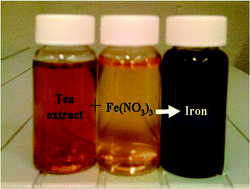In vitro biocompatibility of nanoscale zerovalent iron particles (NZVI) synthesized using tea polyphenols
Abstract
A “green” protocol was used for the rapid generation of nanoscale zerovalent

* Corresponding authors
a
Sustainable Technology Division, National Risk Management Research Laboratory, Environmental Protection Agency, 26 West M. L. K. Drive, MS 443, Cincinnati, Ohio, USA
E-mail:
varma.rajender@epa.gov
b Applied Biotechnology Branch, Human Effectiveness Directorate, Air Force Research Laboratory, Wright-Patterson AFB, OH, USA
A “green” protocol was used for the rapid generation of nanoscale zerovalent

 Please wait while we load your content...
Something went wrong. Try again?
Please wait while we load your content...
Something went wrong. Try again?
M. N. Nadagouda, A. B. Castle, R. C. Murdock, S. M. Hussain and R. S. Varma, Green Chem., 2010, 12, 114 DOI: 10.1039/B921203P
To request permission to reproduce material from this article, please go to the Copyright Clearance Center request page.
If you are an author contributing to an RSC publication, you do not need to request permission provided correct acknowledgement is given.
If you are the author of this article, you do not need to request permission to reproduce figures and diagrams provided correct acknowledgement is given. If you want to reproduce the whole article in a third-party publication (excluding your thesis/dissertation for which permission is not required) please go to the Copyright Clearance Center request page.
Read more about how to correctly acknowledge RSC content.
 Fetching data from CrossRef.
Fetching data from CrossRef.
This may take some time to load.
Loading related content
